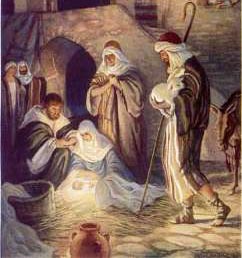Liturgically speaking, Christmas Eve is probably the most neglected
day of the church year, and particularly so when it falls on a Saturday.
Few participate in the morning mass, and rarely does the proper
vigil liturgy itself get celebrated. That is a pity. The Gospels
for the two masses share a unique feature, from which we could learn
much.
Suppose we had a cultural exchange visitor this Christmas from outer
Mongolia, and she asked us what this celebration was all about.
“Who was this Jesus?” How many of us would answer by
starting, as St. Matthew does: He was “. . . son of David,
son of Abraham. Abraham fathered Isaac; Isaac fathered Jacob; Jacob
fathered . . .” This seemingly endless list of “begettings”
does not serve some obscure purpose, no longer relevant to us 2000
years later. It actually is central to our story. Matthew tells
us that we cannot understand Jesus if we are unfamiliar with the
totality of God’s relationship to Israel, extending back all
the way to Abraham. The person we know as Jesus is the fulfillment
of that long story – not in a mechanical sense of acting out
old predictions, but in the fullest expression of who God Himself
is, a more complete demonstration of God’s love than could
have been possible in the story of His relationship with Israel.
So the Hebrew Bible – what we call the Old Testament –
is not something of merely historical interest, now obsolete or
superseded. Rather it is the bedrock foundation of our bond with
Jesus.
The Gospel for the morning mass is Zachary’s song of praise
after recovering the gift of speech on the birth and naming of John
the Baptist. Religious are familiar with this song, the Benedictus,
because it is the Canticle for morning prayer in the Divine Office;
but many of the rest of us may be less aware of this treasure. The
best evidence indicates that it was one of the hymns of the very
earliest Jewish Christian communities who, when gathered to celebrate
God’s victory in Jesus, sang “. . . He has visited His
people, He has set them free!” St. Luke inserted it into his
narrative of the Baptist’s birth because it fit so perfectly.
Like St. Matthew in his detailing of the origins of Jesus, these
earliest Christians expressed their praise and gratitude in the
language of their scriptural tradition. Virtually every line and
phrase in the Benedictus is a quote from, or has a parallel in,
the Psalms and the songs of praise recorded in the Prophets and
the historical books. It is a beautiful mosaic built exclusively
of Old Testament tiles. Like St. Matthew, these first Christians
understood Jesus to be the fulfillment of the long tradition of
God’s relationship with Israel. When we recite (or better:
sing) the Benedictus, we hold hands across the centuries with those
very first Christians.
There has been a lot of interest in recent years among adopted children
to learn who their birth parents were and, perhaps, to learn something
about them. We Christians are the adopted children of Israel, and
it makes even more sense for us to become familiar with the root
stock onto which we have been grafted. When the Christmas clutter
has been put away and we ponder New Year’s resolutions (most
of which we won’t keep), it might be a good idea to resolve
to become more familiar with our roots – God’s relationship
with Israel.
|
